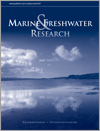Marine and Freshwater Research
Volume 72
Number 11 2021
Australian salt lakes support a unique array of mostly endemic invertebrates. To effectively manage threats to Australia’s unique salt lake faunal communities, it is important to understand what is known and to highlight critical knowledge gaps. This study synthesises available information on the taxonomy, ecology and life history of halophilic crustaceans and gastropods, identifying knowledge gaps and outlining their conservation implications.
Three hundred mangrove trees and saplings were salvaged from a construction site in the Arabian Gulf and relocated in an artificial tidal channel. After 1 year, 31% of the relocated mangroves had survived and grown, demonstrating that, in arid regions where growth is extremely slow, the relocation of mature, salvaged trees can establish fully functioning mangrove habitat faster than newly planted seedlings.
In this study, Sentinel-1 Earth observation (EO) data were explored using support vector machine (SVM) and random forest classifiers to provide a sustainable and cost-effective approach to mapping mangroves. Sentinel-1 data and SVM successfully mapped the mangroves in the Keta Lagoon Complex Ramsar Site, and provide opportunities to overcome mapping limitations within landscapes where the use of optical EO datasets is challenging because of persistent cloud cover.
We examined >30 years of fish sampling data and found that numerous data-deficient marine fishes were represented in existing routine monitoring data. Although some species were rarely reported, several species were encountered hundreds to thousands of times. Using these records, we provide species-specific information about gear, season and location for several marine fishes that are poorly known.
This study examines the effects of environmental cues likely to change for wetlands in the future, namely, temperature and water depth. The results demonstrated that the abundance and assemblage composition of microcrustacea varied by temperature but not by depth. Temperature also had a greater effect on non-ostracods, which will influence food availability for larval and juvenile native fish and, hence, recruitment.
Beach-washed logs have been shown to negatively affect marine turtle nesting. This study uses spatial analysis, as well as species identification and ocean current modelling, to determine the impact and origin of beach-washed logs on Milman Island, northern Great Barrier Reef. Because Milman Island is an index nesting site for the endangered hawksbill turtle Eretmochelys imbricata, we make recommendations on management actions to remove the threat of beach-washed logs.
Using 15 mesocosms we showed N or N+P enrichment stimulated two phytoplankton blooms across enrichment periods, with the dominant species shifting from diatoms to dinoflagellates in both winter and summer in Daya Bay. Accordingly, N+P enrichment enhanced phytoplankton primary production, as well as the abundance and productivity of bacteria. N+P enrichment increased both community respiration and the variation in net community production, indicating that this coastal ecosystem may become more fragile in the future as inputs of land-derived nutrients continue.
The study of shark movement has attracted considerable attention over the past decades. Conventional tagging remains a cost-effective approach for studying shark life history. The current study has provided evidence of the contrasting movement of sharks on the basis of almost three decades of tagging efforts distributed across Western Australia, where >12 000 sharks and rays have been tagged to date. Our study identified differences in relative movement patterns of Western Australian sharks and showed that valuable movement information can be obtained from conventional tagging.
Sex reversal (feminisation) using oestradiol was performed in pest fish, Gambusia holbrooki. Oestradiol was administered orally via food to two groups of G. holbrooki at different life stages, namely, neonates and embryos through gravid females. A complete feminisation was achieved at both life stages. Feminised fish showed comparable survival rate and the reproductive fitness of treated female broodstock was not jeopardised.
Caridina shrimps are ecologically important components of freshwater ecosystems. The population genetic structure of many threatened species is unknown, impeding effective conservation. Through extensive genetic assessment, we show that some geographically restricted (and vulnerable) species exhibit much stronger population structuring than the wide-ranging species in Hong Kong. This has pronounced implications for evolutionary and ecological research, as well as conservation management.
A common feeding association among reef fishes involves nuclear and follower species, where the former disturbs the bottom, during which the latter opportunistically feeds on items exposed. Here, we report such interactions between Western Australian common octopuses and brown-spotted wrasse observed on eight occasions while snorkeling at four temperate-water reefs along the coast of Perth in Western Australia. We compare the interactions observed to other octopus-fish nuclear–follower associations known.
Research is urgently needed to evaluate whether non-structural deterrents are feasible within lock or canal environments. Common carp and Ictiobus were tracked for 6 days and nights in a canal-like environment while exposed to an underwater speaker or strobe-lights. Avoidance responses were weak and varied widely among individual fish. Effective acoustic deterrents require acoustic refuge.
The coral skeleton is populated by microbial algae that can bloom during coral bleaching events. We assessed how common these blooms were during a marine heatwave on Heron Island that caused coral bleaching in 2020. Over one-fifth of bleached corals had algal blooms in their skeleton, indicating the importance of these microbes in affecting reef responses to climate change.





